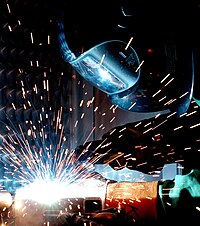
Photo from wikipedia
Abstract Gravity has a significant influence on weld performance during variable polarity plasma arc (VPPA) welding of aluminum alloys. Micro-structures, residual stress, hardness and tensile strength of welded joints using… Click to show full abstract
Abstract Gravity has a significant influence on weld performance during variable polarity plasma arc (VPPA) welding of aluminum alloys. Micro-structures, residual stress, hardness and tensile strength of welded joints using vertical-up and horizontal welding have been investigated and discussed. Micro-structures and residual stress in the welded joint for vertical-up welding were symmetrical. This is in contrast to the horizontal welding, which tends to have asymmetric and inhomogeneous micro-structures that lead to poor mechanical properties. In the upper-side of welded joints for horizontal welding, larger grain sizes brought about lower hardness and lower tensile strength. For the horizontal welded joint, the grain size near the fusion line (FL) on the upper-side was about 113.9 ± 28.8 μm and the tensile strength was 89.2% of the base metal (BM), while for the veritcal-up welded joint, the grain size was about 66.9 ± 16.2 μm and the tensile strength was 98.0% of the BM. On the horizontal welded joint, the fracture section, which had many deep dimples and tear ridges, appeared only on the upper-side of welded joint. The difference of mechanical properties between bilateral sides was caused by gravity driving the melting metal flow. Finally, an optimized mechanism of symmetrical metal flow based on the upper wire feed position was proposed. The revised welded joint was improved significantly and the residual stress on both sides was symmetric.
Journal Title: Journal of Manufacturing Processes
Year Published: 2019
Link to full text (if available)
Share on Social Media: Sign Up to like & get
recommendations!